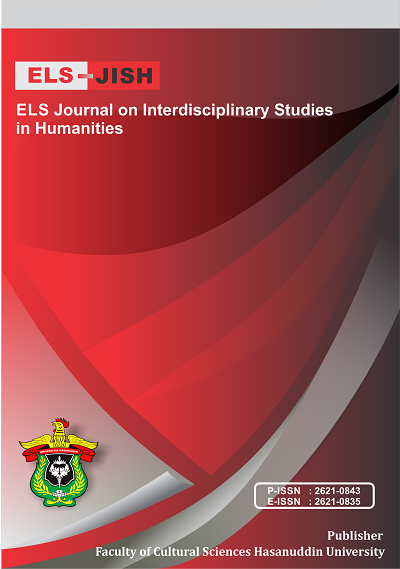Factors Causing Language Anxiety of EFL Students in Classroom Presentation
DOI:
https://doi.org/10.34050/els-jish.v3i2.9718Keywords:
ANXIETY, EFL STUDENTS, PRESENTATIONAbstract
AbstractThe purpose of this study is to identify : (1) Types of foreign language anxiety experienced by the students (2) factors causing language anxiety of EFL students. This research applied qualitative descriptive research method. It was carried out at Graduate Program of Makassar State University. The subject of this study were six students majoring in English who conducted a presentation seminar. They are all selected by using purposive sampling. The researcher observed and interviewed all G-class students conducting presentation seminar from February to April to identify type and factor of anxiety experienced by the students in a presentation seminar. The researcher made observations using video recording devices and field notes. Based on the result, there were three types of anxiety experienced by the students when doing presentation using English, namely anxiety related to positive (facilitative anxiety), anxiety related to negative or destructive (debilitative anxiety) and anxiety which was not related to any of them. The researcher called it as non-effecting anxiety. As for some factors causing the students feel anxious in their speaking ability, generally they divided into two main factors, namely internal and external factors, but in the case of this study, the researcher found only internal factors.Downloads
References
Awan, R.-N., Azher, M., Anwar, M. N., & Naz, A. (2010). An Investigation Of Foreign Language Classroom Anxiety And Its Relationship With Students Achievement. Journal of College Teaching & Learning (TLC), 7(11). https://doi.org/10.19030/tlc.v7i11.249
Chen, Y. (n.d.). ESL Students’ Language Anxiety in In-Class Oral Presentations. 92.
Dolly J. Young. (1986). The Relationship Between Anxiety and Foreign Language Oral Proficiency Ratings. Retrieved from https://doi.org/10.1111/j.1944-9720.1986.tb01032.x
Januariza, Y., & Hendriani, S. (2016). Student’anxiety in learning speaking. 7.
Khairi Izwan Abdullah, N. L. B. A. R. (n.d.). A study on second language speaking anxiety among utm students. 6.
Lucas, R. I., Miraflores, E., & Go, D. (2011). English Language Learning Anxiety among Foreign Language Learners in the Philippines. 7, 26.
Matthew B. Miles, A. Michael Huberman, Johnny Saldana (last). (2014). Qualitative Data Analysis (The Third Edition). Retrieved from https://books.google.co.id/books?id=3CNrUbTu6CsC&printsec=frontcover&hl=id#v=onepage&q&f=false
Negari, G. M., & Rezaabadi, O. T. (2012). Too Nervous to Write? The Relationship between Anxiety and EFL Writing. Theory and practice in language studies, 2, 9. https://doi.org/10.4304/tpls.2.12.2578-2586
Piniel, K., & Csizér, K. (2013). L2 motivation, anxiety and self-efficacy: The interrelationship of individual variables in the secondary school context. 3, 28.
Salehi, M., & Marefat, F. (2014). The Effects of Foreign Language Anxiety and Test Anxiety on Foreign Language Test Performance. Theory and Practice in Language Studies, 4(5), 931–940. https://doi.org/10.4304/tpls.4.5.931-940
Selvam, P., Swaminathan, V. N. G., & Baskaran, S. (n.d.). Effects of debilitative and facilitative anxiety on speaking in second language among malaysian esl learners. 20.
Shangping, L., & Qingyan, C. (2015). Research on Classroom Anxiety in Foreign Language Learning. English Language Teaching, 11.
Smith, A. R. (2016). The relationship between anxiety and risk taking is moderated by ambiguity. Personality and Individual Differences, 5.
Tanveer, M. (2008). Investigation of the factors that cause language anxiety for ESL/EFL learners in learning speaking skills and the influence it casts on communication in the target language. https://doi.org/10.13140/RG.2.1.1995.1129
Yabarmase, D. (2013). The fishbowl strategy: An effective way to improve students’ speaking ability. 9(2)

















